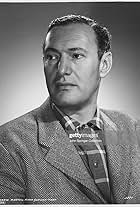Andrew Marton(1904-1992)
- Director
- Second Unit Director or Assistant Director
- Editor
Budapest-born Endre Marton began in the film industry as an editor and
assistant director with Vita and Sascha Films in Vienna. Following a
brief sojourn in Hollywood with
Ernst Lubitsch in 1923, he returned to
Germany, having being signed as chief editor by the Tobis company. He
made his directorial debut with an independently produced British
mystery,
Dreary House (1928).
As a Jew, he was one of many talented film makers forced to flee
Germany after the Nazis rose to power.
Marton had spent much of his youth in the Tyrolean Alps, nurturing an adventurous spirit and developing a fondness for spectacular mountain scenery and skiing. This was certainly a contributing factor to his being hired by MGM, initially to direct the ski sequences for Greta Garbo's Two-Faced Woman (1941). Later, his work was increasingly typified by outdoor adventure subjects, like The Wild North (1952), Green Fire (1954) and Storm Over Tibet (1952) (a remake of his earlier effort Der Dämon des Himalaya (1935), a Swiss production shot on location in Tibet). Taking risks was always inherent in Marton's preoccupation with achieving suspense and an authentic feel for location. For instance, during the filming for 'The Wild North' in Sun Valley, Idaho, he and actor Stewart Granger fell into an icy crevice and were trapped there for more than two hours. One of his more prestigious assignments came about by chance, when he was tasked with replacing Compton Bennett as director of King Solomon's Mines (1950), after the latter had been taken ill.
His chief claim to fame, however, lay in some excellent work as second-unit director, notably in charge of the chariot race for William Wyler's Ben-Hur (1959), as well as of the Normandy invasion sequences for the World War II epic The Longest Day (1962). After his contract with MGM expired in 1954, Marton founded his own production company in conjunction with fellow Hungarian émigrés Ivan Tors and Laslo Benedek. He later concentrated on TV adventure series, helming the pilots, respectively for Daktari (1966) and Cowboy in Africa (1967).
Marton had spent much of his youth in the Tyrolean Alps, nurturing an adventurous spirit and developing a fondness for spectacular mountain scenery and skiing. This was certainly a contributing factor to his being hired by MGM, initially to direct the ski sequences for Greta Garbo's Two-Faced Woman (1941). Later, his work was increasingly typified by outdoor adventure subjects, like The Wild North (1952), Green Fire (1954) and Storm Over Tibet (1952) (a remake of his earlier effort Der Dämon des Himalaya (1935), a Swiss production shot on location in Tibet). Taking risks was always inherent in Marton's preoccupation with achieving suspense and an authentic feel for location. For instance, during the filming for 'The Wild North' in Sun Valley, Idaho, he and actor Stewart Granger fell into an icy crevice and were trapped there for more than two hours. One of his more prestigious assignments came about by chance, when he was tasked with replacing Compton Bennett as director of King Solomon's Mines (1950), after the latter had been taken ill.
His chief claim to fame, however, lay in some excellent work as second-unit director, notably in charge of the chariot race for William Wyler's Ben-Hur (1959), as well as of the Normandy invasion sequences for the World War II epic The Longest Day (1962). After his contract with MGM expired in 1954, Marton founded his own production company in conjunction with fellow Hungarian émigrés Ivan Tors and Laslo Benedek. He later concentrated on TV adventure series, helming the pilots, respectively for Daktari (1966) and Cowboy in Africa (1967).









































